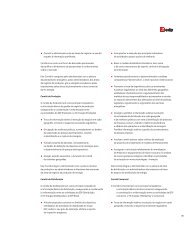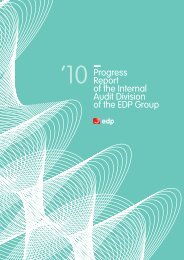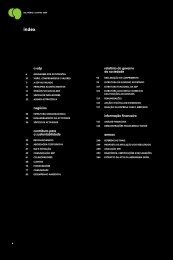Annual Report - EDP
Annual Report - EDP
Annual Report - EDP
- No tags were found...
Create successful ePaper yourself
Turn your PDF publications into a flip-book with our unique Google optimized e-Paper software.
: corporate governance :most important business units and consolidatedamounts in the Business Plan. It also uses topdownmethods to estimate amounts at risk andmake comparisons with its competitors basedon the market performance of <strong>EDP</strong> sharesand public financial information. The aim is toextrapolate to broader horizons the effects ofchanges in composition of its business portfolio.This tool answers the following question: Do themost important business decisions take accountof the impact on <strong>EDP</strong>’s aggregate risk?º º Governance and risk management. Thiscomponent of the risk management process isbased on the corporate policy on business riskmanagement set out by the Executive Boardof Directors and on the structure set up forthe purpose. This tool answers the followingquestions: Are there risk management andcontrol processes? Are they effective?The most important activities in 2012 were as follows:º º Upgrade of the risk portal - Improvementswere incorporated to better adapt the systemto users’ needs, including simplifying theclassification of risks, providing across-theboardinformation and changing the informationin the risk files.º º Six-monthly report on the <strong>EDP</strong> Group’s Top 5Risks and Uncertainties - The report analysesthe five uncertainties of the company’s activitythat, due to their potential for rapid developmentor significant impact on the <strong>EDP</strong> Group, warrantspecial attention from the corporate structure.º º Active contribution to Eurelectric’s FocusGroup Enterprise Risk Management, TaskForce Risk Analysis and Recommendationson Eurelectric’s Power Choices Study andInvestment Action Plan.º º Third meeting of <strong>EDP</strong> Group Risk Officers - Itincluded presentation of relevant issues to thecompany in terms of risk management by theRisk Management Department, with importantlearning goals and the exchange of experiencesbetween employees from the different businessunits and the Corporate Centre.º º <strong>EDP</strong> Serviço Universal was assisted in theanalysis of the risks associated with deviationsfrom forecasts of demand in regulatedconsumption and supply of renewable generation.º º We conducted an aggregate top-down analysisof the risk and compared it with competingcompanies. It continued to show a low degree ofaggregate risk for the <strong>EDP</strong> Group’s businesses.An assessment of intrinsic EDF – expecteddefault frequency (using Moody’s KMV CreditEdge model) confirmed the evaluation and isstill not in line with the decreases in rating (to:S&P BB+; Moody’s Ba1), which are due basicallyto the drop in Portugal’s rating and the limit onthe number of levels that a rating can be abovethe sovereign rating. There was also a sharpdrop in <strong>EDP</strong>’s credit default swaps.º º The aggregate bottom-up risk analysis modelswere reformulated to increase the accuracyof risk measurements and allow differentbehaviours and non-linear associations betweenthe different businesses’ main risk factors.º º Bottom-up risk analysis of Grupo <strong>EDP</strong> Brasilwas conducted and the main risks of thegeneration, distribution and supply businesseswere analysed.º º Methods were developed for forecasting trends,volatilities and correlations of commodities andexchange rates followed by publication of ascientific article, internal use of the bottom-uprisk analysis model and a quarterly report.º º We continued to implement counterparty riskassessment models developed with the TradingUnit and Financial Management Department,118including limit structures and calculation of theamount at risk.º º We analysed the stylised development of theelectricity system in the Iberian Peninsulaand the degrees of return risk-of futurecompositions of the Portuguese and Spanishgeneration system in view of the higher contentof renewable generation and assessed thenecessary backup and storage costs to dealwith the volatility of generation from renewableenergy sources.º º Risks and opportunities for <strong>EDP</strong> of greaterinterconnection of European electricitysystems, such as between Portugal and Spain,Spain and France and MIBEL market couplingwith France.º º We analysed the country risks of the countriesin <strong>EDP</strong>’s current portfolio and those identifiedas targets – diversification effect and impacton the risk of the Group’s portfolio.The business units manage their own risks withinestablished criteria and delegations. There isa dual reporting system between each businessunit’s Risk Officer and the Director of the RiskManagement Department to ensure alignmentof updates, reporting and control.II.5.2.2. Risk factorsThe diagram below summarises the <strong>EDP</strong> Group’smain risk factors.BusinessRisksInvestmentassociated risksRegulatory risksEnvironmentalriskMarketRisksEnergymanagementEnergy volumeand price riskFinancial riskRiskFactorsOperacionalRisksInsurable risksIT risksRisks withprocesses andpeopleLegal andlitigation riskCreditRisksSuplyCounterpartyThe business risk is the most importantcomponent, followed by the market, operationaland credit risks. This is a typical situation for theutility companies in the sector.The Group has managed the political andregulatory risk very carefully and been ableto avoid bad choices leading to damaging lossof value. This risk can be high in the transitionphase, which is the current situation, and lowin stable conditions. From the point of view ofstability, the <strong>EDP</strong> Group continues to have a lowrisk profile, given its lower structural exposureto the market risk. The regulated nature of mostof the Group’s businesses (around 90%, includinggeneration with CMECs and long-term contracts)has made it possible to borrow substantially,which is typical of 100% regulated companies andfollow a strategy of rapid growth, especially inrenewable energy. However, this advantage willtend to shrink in the future due to the terminationof CMEC mechanism for the plants under it(whichwill undergo a final review in 2017), increasing theinstalled capacity of power stations in the marketand natural greater exposure to the exchangerisk resulting from growth in businesses outsidethe euro area. According to internal risk analysis,<strong>EDP</strong>’s business risk has remained low.The political and regulatory risk in Portugal hasbeen influenced by the measures taken under theEconomic Adjustment Programme agreed uponA World Full Of Energy
















